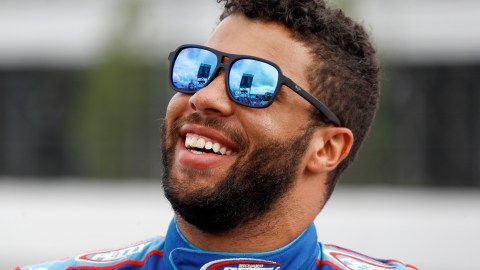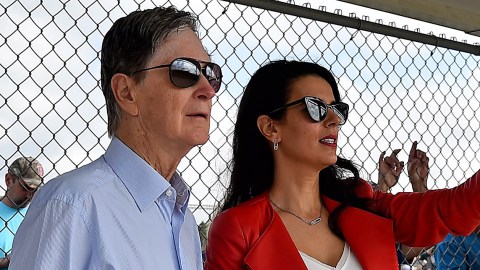Paul Pierce was missing from the Celtics' preseason game Sunday, having stayed at home with a sore heel while the Celtics traveled to Toronto. Jeff Green was also a no-show, as he will be all season with his heart condition.
Yet it's possible the absence that was most noticeable wasn't that of the future Hall of Famer or crucial sixth man, but of a versatile forward who became something of a cult hero during his time in Boston.
Glen Davis is no longer a Celtic, having been traded with guard Von Wafer to Orlando this offseason for power forward Brandon Bass. This has disturbed some fans, who cling to Davis' memorable "Shrek and Donkey" performance and the season highs he posted with 11.7 points and 5.5 rebounds per game last season.
Bass' uneven introduction to the Celtics' offense and defense on Sunday, when he mishandled two passes from Rajon Rondo, might feed the belief that Davis-for-Bass wasn't a good deal for the Celtics.
In fact, it was not only a good deal, but a great deal based on the evidence at hand.
It's dangerous to lean too heavily on total statistics to judge a player's performance. Nearly everyone acknowledges this, to some degree, by using per-game averages rather than cumulative totals to determine who is the best scorer, rebounder, etc. in the league. A player who appears in 70 games and averages 28 points in those games is widely accepted to be a better scorer than a player who appears in 80 games and averages 25 points, even though the latter player will have scored more points overall.
Taken a step farther, how a player is used during games is just as important as how many games he plays. Davis' high production last year was a textbook example.
First, let's look at those 11.7 points and 5.5 rebounds per game. Not only were those career highs for Davis, but so was his 29.5 minutes per game. That was 12 minutes and 12 seconds more time to collect boards than Davis had the previous year.
He also came close to doubling his field goal attempts, going from 5.2 shots per game in 2009-10 to 10.3 in 2010-11. At the same time, his field goal percentage hardly budged from 43.7 percent to 44.8 percent, yet his scoring ballooned from 6.3 points to 11.7. So Davis increased his shot attempts by 198 percent (5.2 to 10.3) while only increasing his actual scoring by 186 percent (6.3 to 11.7). In other words, he became less efficient while taking more shots.
What's the problem with that? After all, Michael Jordan, Kobe Bryant and Allen Iverson famously attempted between 25-30 shots in some games. It's an accepted trade-off to get 30-35 points from the best player on the floor.
The difference is that virtually every minute those players were playing, they were indeed the best players on the court. But according to player efficiency rating, which rates a player's impact every minute he plays, Davis was most likely never even one of the top four players on the court, and he was way, way worse than Bass.
He may even have been worse, statistically speaking, than newly acquired bruiser Chris Wilcox.
The table below breaks down three relatively new NBA statistics. It compares Davis, Bass and Wilcox in terms of usage rate, true shooting percentage and player efficiency rating, according to Hoopdata.
| Glen Davis | Brandon Bass | Chris Wilcox |
|---|---|---|
| USG: 20.90 | USG: 19.72 | USG: 18.91 |
| TS%: 49.9 | TS%: 57.15 | TS%: 58.7 |
| PER: 12.86 | PER: 15.98 | PER: 18.04 |
Looks like a bunch of mumbo jumbo, probably. The last number (PER) is player efficiency, which we've been over. The first (USG) is usage rate, which calculates the plays that ended with a player attempting a shot, getting fouled or turning the ball over. Simply put, it counts how many of a team's plays ended with that player doing something.
The second (TS%) is true shooting percentage, which weighs shot attempts based on difficulty, since 3-pointers are more difficult than dunks (depending on your vertical), for example.
Take a look at the table again. Davis had a greater usage rate, yet a lower true shooting percentage and a criminally lower PER than either Bass or Wilcox. Yeah, his traditional numbers increased last season — but only because he had more opportunities to do stuff.
The statistical stuff is just part of the equation. As the recent lockout proved, it's all about money, and the Magic will now pay Davis a reported $26 million over the next four years to be sort of average. Meanwhile, the Celtics have Bass under team control for this year and next at about a reported $4 million per year, and Wilcox is making about the minimum salary.
The intangibles weigh in Bass' favor as well. In Bass, the Celtics have a back-to-the-basket post player they didn't have in Davis, and they still have a backup big man who can knock down a midrange jump shot. Bass won't be as animated, but that will partly be because he won't have to freelance as much to get off an unconventional shot.
Davis was entertaining, both for his style of play and his postgame interviews, but from a basketball perspective, he won't be missed. What the Celtics lost in fun, they've gained in cold, hard production.



